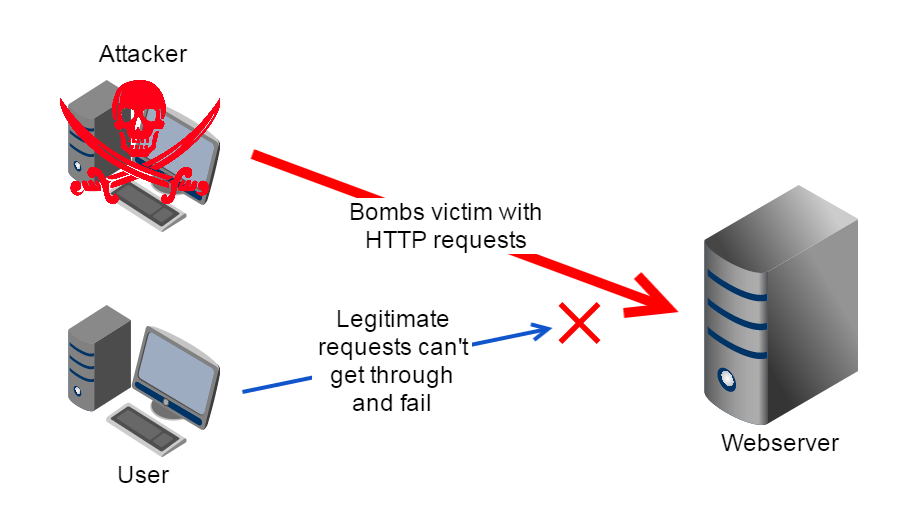Recently our team was tasked with creating a demo to illustrate the effects of Denial of Service (DoS) attacks. As I was particularly interested in how the available attack tools work I studied the sourcecode of one of them – the Low Orbit Ion Cannon. In this post is will cover the surpising simplicity of the implementation. However to get a context let’s start first with discussing how DoS attacks generally work, illustrated on the basis of the following setup:
In our simple demo network there are only three participants: A central webserver as victim, a legitimate user that wants to connect to the webserver and an attacker. In the beginning the legitimate user can browse the webpage hosted on the webserver smoothly. However as soon as the attacker starts his DoS attack the legitimate user’s requests either take very long to finish or even fail completely. This instability is caused by the attack overloading either the webserver’s connection or the server process itself.
One tool an attacker could use for these kind of attack is the free and open source Low Orbit Ion Cannon. It is a very easy to use application with a nice graphical user interface. The video embedded below contains a short walk though.
Now let’s get our hands dirty: To find out how the application attacks the victim’s server in detail we have to download and analyse the source. Below is a cleaned up and simplified version of the method responsible for carrying out the actual HTTP Denial of Service attack.
byte[] buf = System.Text.Encoding.ASCII.GetBytes(String.Format("GET {0} HTTP/1.0{1}{1}{1}", Subsite, Environment.NewLine));
var host = new IPEndPoint(System.Net.IPAddress.Parse(IP), Port);
while (this.IsFlooding) {
byte[] recvBuf = new byte[64];
var socket = new Socket(AddressFamily.InterNetwork, SocketType.Stream, ProtocolType.Tcp);
socket.Connect(host);
socket.Send(buf, SocketFlags.None);
socket.Receive(recvBuf, 64, SocketFlags.None);
}
To my surprise the method was a lot shorter and less complex than I expected. I will now try to walk you trough the functionality so that you also understand what is going on even if you are not a developer .
In the first two lines the application prepares the attack’s underlying HTTP request and sets the target IP address and the target port. Although it’s done in an rather unusual way it’s a legitimate implementation for an application requesting data from an external HTTP service. In the following third line the while command tells the system to repeat all enclosed and indented further commands. Within this section the actual attack is launched. However to do so two more things need to be prepared: At first in line 5 a buffer called recvBuf is created that is used to store the subsequential answer from the victim and in line 6 further connection details like the use of the TCP protocol are specified. Finally in line 8 the network connection to the victim’s server is established and in line 9 the HTTP request that was created in the beginning is sent. The subsequent receive method call in line 10 stores the first 64 byte of the server’s reply in the previously created receive buffer recvBuf. This forces the application to wait for the server to reply before it moves on. Until now we behaved like a normal web browser. However as the last command within the while loop was reached the whole process beginning at line 5 is repeated. Again and again and again …
What that means is we didn’t really use any service and just created unnecessary load on the server and the network connection. As the attack requests are generally repeated as fast as possible and are executed in parallel this load can render services unusable or even bring them down completely. This is especially true for Distributed Denial of Service (DDoS) attacks where many attackers or their bots join forces to attack a target as happend to the Playstation Network in 2014.
To recap: The sourcecode contains no nasty little tricks or algorithms that require any special knowledge. That means you don’t need to be a genius to write an effective and widely used Denial of Service attack tool. For me that is somewhat frightening!
